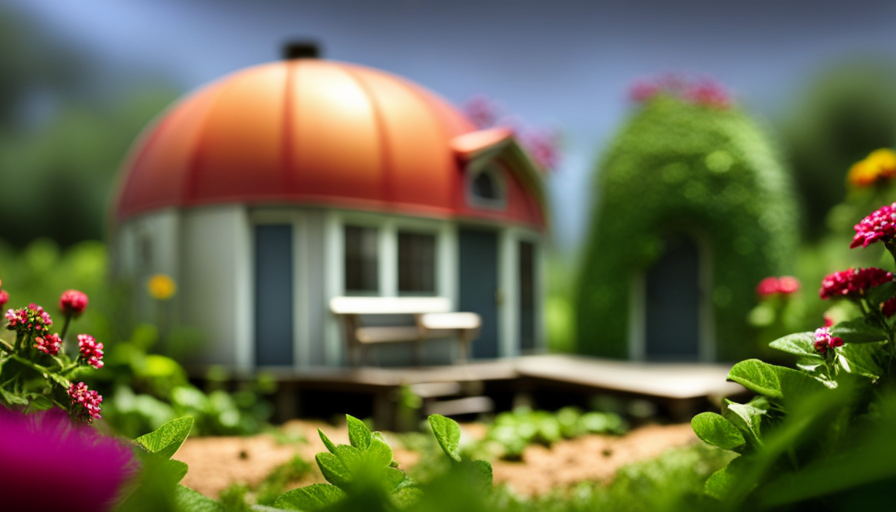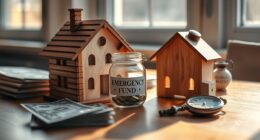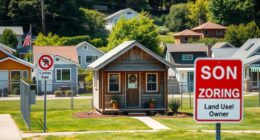Have you ever thought about the maximum height of a tiny house on wheels?
Well, welcome to the world of vertical living! In this article, we will delve into the fascinating realm of tiny houses and explore the heights they can reach.
From legal restrictions to clever storage solutions, we will uncover the secrets of maximizing vertical space in designing these compact abodes.
With a focus on safety considerations and tips for moving a tall mobile tiny house, we will equip you with the knowledge to navigate the challenges of elevated designs.
Get ready to be inspired as we take a global tour of unique vertical tiny house designs that push the boundaries of what’s possible.
So, buckle up as we embark on a journey to uncover just how high a mobile tiny house can soar!
Key Takeaways
- Mobile tiny houses are designed to maximize vertical space with lofted sleeping areas and built-in storage solutions.
- Compliance with height restrictions is necessary and requires consideration of zoning laws and transportation limitations.
- Variance applications may be possible to exceed height restrictions, but the process is complex.
- Efficient use of vertical space is essential when designing a tiny house, utilizing space-saving furniture options and clever storage solutions.
Understanding the Basics of Mobile Tiny Houses
You might be surprised by just how much you can learn about the fundamentals of mobile tiny houses. When it comes to vertical space utilization, mobile tiny houses are experts at making the most of every inch. Due to their compact size, these homes are designed to maximize vertical space by incorporating features such as lofted sleeping areas, built-in storage solutions, and multi-functional furniture.
This allows for efficient use of the limited square footage available, providing ample living space despite the small footprint.
The benefits of mobile tiny houses go beyond their ability to optimize vertical space utilization. These homes are incredibly versatile and can be easily transported from one location to another. Their mobility allows for a sense of freedom and adventure, as you can take your home with you wherever you go. Additionally, mobile tiny houses are often more affordable than traditional homes, making them an attractive option for those looking to downsize or live a more minimalist lifestyle.
Understanding the basics of mobile tiny houses sets the foundation for exploring the legal height restrictions that govern these unique dwellings. These regulations play a crucial role in determining how high a mobile tiny house can be, and will be further discussed in the next section.
Legal Height Restrictions for Mobile Tiny Houses
Imagine a world where there were no restrictions on the maximum height of a portable compact dwelling. Unfortunately, in the real world, understanding the legality of tall mobile tiny houses is crucial.
Overcoming height restrictions for mobile tiny houses requires careful consideration of local building codes and regulations. Here are three important factors to keep in mind:
-
Zoning laws: Different areas have different regulations regarding the maximum height of structures. It is essential to research and comply with the specific rules in your location to ensure your mobile tiny house meets the height requirements.
-
Transportation limitations: Even if your tiny house complies with height restrictions while stationary, you must also consider its height during transportation. Most regions have regulations on the maximum height for vehicles on public roads, including bridges and overpasses. Ensure your mobile tiny house can safely navigate roadways without exceeding these limits.
-
Variance applications: In some cases, it may be possible to request a variance from local authorities to exceed height restrictions. However, this process can be complex and time-consuming. It requires detailed plans, justifications, and often public hearings. It’s crucial to consult with professionals familiar with local regulations and zoning laws to navigate this process effectively.
Understanding the legality of tall mobile tiny houses and overcoming height restrictions are essential for ensuring compliance with local laws. Once these considerations are addressed, it’s time to move on to the next section about considerations for vertical space in designing a tiny house.
Considerations for Vertical Space in Designing a Tiny House
When designing your compact dwelling, don’t forget to consider the efficient use of vertical space. In a mobile tiny house, every inch counts, so it’s essential to plan the vertical space carefully. One way to maximize vertical space is by incorporating space-saving furniture options. These cleverly designed pieces can serve multiple functions, such as a sofa that transforms into a bed or a dining table that folds down when not in use. To emphasize the importance of vertical space planning, consider the following table:
| Furniture Piece | Function | Vertical Space Utilized |
|---|---|---|
| Murphy Bed | Bed | Wall |
| Lofted Bed | Bed | Ceiling |
| Wall-mounted Shelves | Storage | Wall |
| Hanging Organizer | Storage | Door or Wall |
| Foldable Table | Dining | Wall or Floor |
By utilizing these space-saving furniture options, you can make the most of your vertical space and create a more functional living area. Maximizing vertical space with clever storage solutions is the next step in creating a well-designed mobile tiny house.
Maximizing Vertical Space with Clever Storage Solutions
To make the most of your compact living space, consider incorporating clever storage solutions that maximize vertical space. In small apartments or tiny houses, where every inch counts, utilizing vertical space is essential. Here are some effective strategies for organizing small closet spaces and maximizing vertical space in your mobile tiny house:
-
Install adjustable shelves: You can customize the height and spacing of adjustable shelves according to your storage needs. This flexibility ensures that you can efficiently utilize the available vertical space.
-
Use hanging organizers: Hanging organizers, such as shoe racks or fabric shelves, can be hung on the back of doors or inside closets. They provide additional storage space for items like shoes, accessories, or folded clothes.
-
Opt for wall-mounted storage: Wall-mounted storage solutions, such as hooks, pegboards, or floating shelves, help to free up valuable floor space and keep your belongings neatly organized.
-
Utilize under-the-bed storage: Invest in bed frames or storage containers with built-in drawers that can be easily accessed and provide ample space for storing items like extra bedding or seasonal clothing.
-
Consider utilizing the ceiling: Install overhead storage racks or hanging baskets to take advantage of the often overlooked space above your head.
By implementing these smart storage solutions, you can optimize the vertical space in your tiny house and keep your belongings organized.
In the next section, we will explore some creative ideas for utilizing vertical space in a tiny house without compromising functionality.
Creative Ideas for Utilizing Vertical Space in a Tiny House
Consider incorporating these creative ideas to maximize vertical space in your compact living area and create a functional and organized space.
One innovative way to utilize vertical space is through vertical gardening. By installing hanging planters or utilizing vertical wall space with mounted shelves, you can create a beautiful and space-saving garden in your tiny house. Not only does vertical gardening add a touch of greenery to your living area, but it also helps purify the air and provides a calming atmosphere.
Another idea to maximize vertical space is by investing in space-saving furniture. Look for pieces that can serve multiple purposes, such as a sofa that can transform into a bed or a dining table that can be folded against the wall when not in use. Additionally, consider incorporating wall-mounted storage solutions, such as floating shelves or hanging organizers, to keep your belongings neatly organized and off the floor.
By implementing these creative ideas, you can fully optimize the vertical space in your tiny house, creating a functional and efficient living area.
In the next section, we will explore innovative designs for multi-level tiny houses, which further maximize the use of vertical space without compromising on comfort or style.
Innovative Designs for Multi-Level Tiny Houses
Don’t you just love how multi-level tiny houses can magically expand your living space without taking up any extra room? The innovative designs for multi-story tiny houses are truly remarkable.
These designs utilize vertical space to its fullest potential, allowing for multiple levels of living space within a compact footprint. One popular design includes a loft area that serves as a bedroom, while the lower level is dedicated to living and dining areas. This clever use of space creates a sense of openness and allows for efficient use of every square inch.
To further maximize space, space-saving furniture ideas are incorporated into these multi-story tiny houses. Foldable tables and chairs, built-in storage solutions, and hidden compartments are just a few examples of the ingenious furniture designs that can be found in these homes. By utilizing these innovative furniture options, homeowners can make the most of their limited space without sacrificing functionality or comfort.
As we explore the pros and cons of adding a loft in a tiny house, it becomes clear that there are both advantages and disadvantages to this design choice. But before we delve into that, let’s first take a closer look at the multi-level tiny house trend and the space-saving furniture ideas that make it possible.
Pros and Cons of Adding a Loft in a Tiny House
After exploring innovative designs for multi-level tiny houses, let’s now discuss the pros and cons of adding a loft in a tiny house. As someone who’s interested in maximizing space in my mobile tiny house, I’ve considered the benefits and drawbacks of incorporating a loft into the design.
-
Increased Living Space: A loft provides additional square footage, allowing for a separate sleeping area or storage space.
-
Privacy: With a loft, you can create a private sleeping area separate from the main living space.
-
Design Flexibility: Lofts can be customized to suit individual needs and preferences, offering opportunities for creativity and personalization.
However, there are also some considerations to keep in mind when adding a loft to a tiny house. These include:
-
Limited Headroom: The height of the loft may restrict movement and limit the ability to stand up straight.
-
Accessibility: Climbing up and down a ladder or stairs to access the loft can be challenging, especially for individuals with mobility issues.
-
Thermal Efficiency: Heat tends to rise, so the loft may be warmer than the rest of the tiny house, requiring additional cooling measures.
With these pros and cons in mind, it’s important to carefully consider the design and layout of the loft in a tiny house. Transitioning to the next section, let’s now delve into the safety considerations for elevated tiny house designs.
Safety Considerations for Elevated Tiny House Designs
When incorporating an elevated design into a compact living space, it’s crucial to prioritize safety measures. Building stability and adherence to safety regulations are of utmost importance. To ensure a secure and stable elevated tiny house, there are several key considerations to keep in mind.
Firstly, it is essential to design a solid foundation that can support the weight and height of the structure. This foundation should be able to withstand external forces such as wind, seismic activity, and the movement associated with transportation.
Secondly, the materials used in the construction should be chosen carefully to ensure durability and structural integrity. High-quality materials that are specifically designed for mobile tiny houses should be utilized to minimize the risk of structural failure.
Lastly, it is crucial to follow safety regulations and guidelines when designing and constructing an elevated tiny house. These regulations may vary depending on the location, so it is important to consult with local authorities to ensure compliance.
By prioritizing building stability and adhering to safety regulations, you can create a safe and secure elevated tiny house. In the next section, we will discuss tips for moving a tall mobile tiny house, ensuring a smooth and secure relocation process.
Tips for Moving a Tall Mobile Tiny House
When considering the safety of elevated tiny house designs, it’s crucial to also plan for the transportation and movement of a tall mobile tiny house. As the height increases, so do the challenges of transporting it safely.
Therefore, here are some tips for securing a tall mobile tiny house during transportation:
-
Choose a sturdy trailer: Make sure the trailer can support the height and weight of the tiny house. It should have a strong frame and reliable suspension system.
-
Reinforce the structure: Strengthen the tiny house by adding additional bracing and support to minimize any potential movement during transport.
-
Secure all loose items: Before hitting the road, make sure all furniture, appliances, and personal belongings are properly secured to prevent damage or accidents.
-
Check for clearance: Be mindful of overhead obstacles such as trees, power lines, or bridges that may pose a challenge due to the increased height of the tiny house.
-
Use a professional transport service: Consider hiring experienced professionals who specialize in moving tall structures to ensure a safe and smooth journey.
Transporting a tall mobile tiny house can be a complex task, but with proper planning and precautions, it’s achievable.
Now, let’s delve into exploring unique vertical tiny house designs from around the world.
Exploring Unique Vertical Tiny House Designs from Around the World
Take a look at how architects in cities like Tokyo have ingeniously utilized vertical space to create tiny living quarters that resemble cozy bird nests, providing a unique and innovative solution for urban living. These unique architectural features allow residents to maximize space while still maintaining a comfortable and functional living environment.
One fascinating aspect of these vertical tiny house designs is the incorporation of vertical gardening techniques. With limited floor space, architects have explored creative ways to bring greenery into the living quarters. Vertical gardens are designed to utilize vertical wall space and can be used to grow a variety of plants, including herbs, vegetables, and flowers. These gardens not only add a touch of nature to the tiny house but also provide a source of fresh produce.
To further illustrate the variety of unique vertical tiny house designs, let’s take a look at the following table:
| Design | Description | Location |
|---|---|---|
| Skyward Tower | A towering structure with multiple levels, each serving a different purpose | Tokyo, Japan |
| Hanging Haven | A suspended tiny house that hangs from tall buildings, utilizing unused air space | New York City, USA |
| Treehouse Retreat | A tiny house built around a large tree, incorporating its natural shape and branches | Vancouver, Canada |
These examples showcase the ingenuity of architects in creating vertical tiny houses that not only maximize space but also offer a unique and innovative living experience.
Frequently Asked Questions
Are there any legal restrictions on the width or length of a mobile tiny house?
There are legal regulations and building codes that dictate the width and length of a mobile tiny house. These regulations vary by jurisdiction and may include restrictions on the maximum width and length of the structure. Compliance with these regulations is necessary to ensure the safety and legality of the mobile tiny house.
It’s important to consult local building codes and zoning laws to determine the specific restrictions in your area.
How can I ensure that my mobile tiny house is structurally sound when built for vertical space?
I know that ensuring the structural soundness of a mobile tiny house built for vertical space can be a concern, but there are several key factors to consider.
Firstly, make sure to use high-quality materials that are suitable for vertical loads.
Additionally, consult with a professional engineer to ensure that the design meets all necessary structural requirements.
Lastly, properly anchor the house to a solid foundation to enhance stability.
What are some alternative storage solutions for maximizing space in a mobile tiny house?
When it comes to maximizing space in a mobile tiny house, there are several alternative storage solutions available.
One option is to utilize vertical space by installing shelves or cabinets that reach up to the ceiling.
Another approach is to incorporate built-in furniture with hidden storage compartments.
Additionally, using multipurpose furniture, such as a sofa with storage underneath or a bed with drawers, can help optimize space efficiency in a mobile tiny house.
Are there any safety concerns or precautions to consider when living in a multi-level tiny house?
When considering living in a multi-level tiny house, there are important safety concerns and precautions to keep in mind. It is crucial to adhere to building codes to ensure structural stability and minimize risks.
Factors such as proper support, railing heights, and fire safety measures must be carefully considered. Additionally, weight distribution and load-bearing capacities should be evaluated to prevent structural failures.
Following these guidelines will help ensure a safe and secure living environment in a multi-level tiny house.
Can you provide examples of unique vertical tiny house designs from different countries?
Vertical tiny house designs in Japan showcase innovative and imaginative approaches to maximizing space. These designs optimize every inch of available area, from multi-level lofts to suspended beds.
South Korea offers creative storage solutions, utilizing hidden compartments and foldable furniture to maintain a clutter-free environment. These designs prioritize functionality and efficiency, allowing residents to live comfortably in compact spaces.
By incorporating these unique concepts, individuals can create a visually appealing and practical vertical tiny house.
Conclusion
In conclusion, the height of a mobile tiny house is subject to legal restrictions and design considerations. It is important to understand the maximum height allowed in your area before constructing or moving a tiny house.
By utilizing clever storage solutions and creative design ideas, vertical space can be maximized in a tiny house. Adding a loft can provide extra living space, but safety considerations must be taken into account.
Moving a tall mobile tiny house requires careful planning and execution. For inspiration, explore unique vertical tiny house designs like the innovative ‘Sky High House’ that features a rooftop garden, providing a breathtaking view and sustainable living experience.
Hi, I’m Emma. I’m the Editor in Chief of Tiny House 43, a blog all about tiny houses. While tree houses are often associated with childhood, they can be the perfect adult retreat. They offer a cozy space to relax and unwind, surrounded by nature. And since they’re typically built on stilts or raised platforms, they offer stunning views that traditional homes simply can’t match. If you’re looking for a unique and romantic getaway, a tree house tiny house might just be the perfect option.










